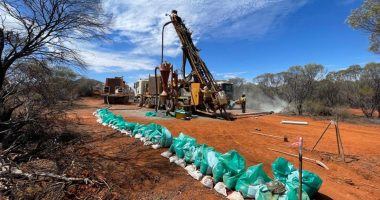A southward cluster of outcropping pegmatites on-site Chariot Corporation’s (ASX:CC9) flagship Black Mountain hard rock lithium project has led management and geotechs to sign off on a promising future drilling target for the company as exploration on-site gathers pace.
That’s a promising development enough for any exploration investor, given that Chariot’s project portfolio can boast to being one of the largest known lithium-prospective landholdings in the entire USA.
The answer as to what tipped Chariot’s geotechs off on locating the new drill target in the first place may be somewhat surprising – because the answer is potassium.
Let’s take a step back and look at what we already know.
Chariot’s Black Mountain project is known to contain large spodumene-bearing pegmatites at surface. Spodumene is a mineral very often lithium-bearing and spodumene with high concentrations of the battery metal is, for some downstream players, the holy grail of hard rock lithium ore.
It was spodumene auctions that pushed Pilbara Minerals to household name status in the early 2002’s when COVID supply chains and robust EV demand saw EV battery original equipment manufacturers (OEMs) collectively act to help push the price of lithium to eye-watering heights.
So, that’s a good indication in itself for any lithium explorer. But Chariot’s latest find on-site isn’t related to spodumene – it has those targets to follow up later.
What Chariot Corporation has been able to do heading into FY25 is use an indicator mineral called feldspar to assist it in knowing where first to place the rig on its massive acreage in Wyoming, USA.
Ok. But what is feldspar?
This is where potassium comes in.
Feldspar – otherwise known as K-Feldspar, with the K indicating the chemical element symbol for potassium – is, for the time-poor, an indicator mineral for lithium mineralisation in certain contexts.
And the context defining at least one southward cluster of pegmatites on-site Chariot’s Black Mountain acreage reflects all the right conditions required to formally sign off on a drill target.
First, some background.
Feldspars are the most abundant mineral group in Earth’s curst, with Resources Victoria for one stating the concentration of feldspars on our planet makes up some 60% of that crust. That feldspar and lithium are closely linked in geological settings is no surprise, given the most common economic deposits of feldspar in mining scenarios is pegmatites.
Pegmatites, of course, are the same types of host rocks that helped propel the lithium explorer boom of the 2020’s forward.
Spodumene, a mineral that contains lithium, is in many contexts contained within pegmatites – leading to the contracted term “lithium pegmatites” which may be familiar to regular readers of this masthead.
So what about feldspar?
Covering the research
Feldspar is a lot like quartz. It’s a silicon-heavy rock, but unlike quarts, Feldspar also contains trace amounts of aluminium. That aluminium makes feldspar a target mineral for glassmaking and ceramics industries.
But feldspar also contains potassium, calcium, or sodium – or combinations thereof. And it’s the potassium element that matters here, because more than one company has successfully used K-feldspar before to identify lithium targets, and in some cases, intercept the battery metal.
Research from Sweden has shown that finding elevated contents of lithium, over 80 parts per million (ppm), is a better and more high-confidence indicator of underground spodumene mineralisation than other methods of indication.
That study found K-feldspar analysis to be a superior methodology compared to looking for lithium in muscovite; muscovite and feldspar are closely linked also – the latter can form as a function of feldspar’s alteration over geological time.
The authors of a Canadian-Spanish paper from 2003 made a similar discovery, writing: “trace-element variation in feldspars and muscovite reflects enrichments in the melt; a higher content correlates with characteristic minerals of these elements.”
Trace element variations lead Chariot’s way
That’s the end of our science lesson for today – but I needed to put you through that to make sense of Chariot’s strategy for Black Mountain.
All in all, Chariot’s geotechs are confident they’ve stumbled onto a target worth time and money because the K-feldspar potassium to rubidium ratios on-site are less than 30; as Chariot sees it, “confirming that [the southward pegmatite cluster remains] the most prospective [target] for lithium mineralisation.”
“Accordingly … now the primary targets for future drilling,” the company wrote on Tuesday.
What else has Chariot’s exploration team excited is that the rocks on-site are highly fractionated. To boil down the geological concept, fractionation occurs over geological time when rocks formed from cooling lava eventually turn into harder minerals like quarts and/or granite (the go-to example used by geology educators.)
Adding to that, three existing drillholes hit lithium oxide near surface. And when Chariot says “near surface,” they mean it – mineralisation commenced at less than 3 metres depth down two of those three drillholes.
As for what the weeks and months ahead bring, take it from Chariot.
“A portable X-Ray Fluorescence (pXRF) device was used on 218 potassium-feldspar (“K-feldspar”) samples collected from the outcropping pegmatites at Black Mountain,” Chariot wrote on Tuesday.
“Many of these samples also displayed anomalous caesium (Cs) and tantalum (Ta) values, further supporting the existence of LCT pegmatites in the area.
“The Company will expand its drilling plans and drill test the Southern Target Area.”
CC9 last traded at 11.5cps – jumping nearly +10% on the news.







